This seems a little, well actually a lot overdue; a review and how-to on the sensational SumpJumper No. 2, my all-time favourite and most productive native lure casting lure.
The No. 2 StumpJumper is the smaller brother of the well-known and respected No. 1 StumpJumper. Originally the middle lure in the range of three, there are now 6 models of StumpJumper lures on the market and all catch fish hand over fist.
My love affair with this lure started on my first native lure casting trip way back when I was just starting university (and that was 1989!). A mate suggested we come up to the Murray and check out what they’d been doing with cast lures and I jumped at the chance. Our first trip was a memory in itself. My mate suggested we tie on a No. 1 Stumpy and go troll a particular stretch of river. We had gone all of 20m when the rod buckled over and a 63cm cod came flapping to the boat.
Next?
He then suggested we tie on the pink and purple No. 2 StumpJumper from Freshwater Fishing and cast to a set of snags along the edge of the river around the third bend near the reeds. That’s sounds easy! Third cast and a golden of 45cm crash tackled the Stumpy and set the hook on my love for Stumpies as much as it set the hook on itself.
Since that first trip, Stumpies have generally been the first and the last lure tied on whenever I fish the Murray. Countless golden perch and a stack of cod have been taken on the No. 2 StumpJumper in the last 20-odd years, and even with their subtle changes in manufacture and features, they continue to produce the goods. But it’s not just goldens and cod, as redfin, Australian bass, flathead and trout have all succumbed to the power of the No. 2 StumpJumper. To say I am addicted to them is a bit of an understatement.
Casting lures at snags seems a simple task. Find a snag, chuck the lure at it and wind it back. And guess what, that approach works sometimes. But there are better ways and ideal areas to use a No. 2 StumpJumper. These areas take into account the diving limitations of the lure on the cast and also the incredible snag resistance. If you know what areas to look for, you’ll have success.
I like to fish in areas from 3’-6’ (0.9-1.8m) deep that have a bit of current and some obvious structure. Lay down logs, dead trees, weed and reed edges with timber and rocky walls all fit the bill. On the cast the No. 2 Stumpy gets down to around a metre and when you add in snags, slower retrieves, pauses and twitches, the lure may actually only ever get down 60cm or so. Don’t fret though, this is enough depth in water less than 2m deep.
The easiest of retrieves, and one that works really well in cooler waters, is a really slow roll. To do this cast well beyond the snag you are targeting and give the reel three or four quick winds. This gets the lure down around a metre deep. From there, slow everything up and try to keep the rod tip bobbing with the beat of the lure. You should aim to hit the snag at some stage of the retrieve as this throws a bit of variation into the swimming action and also creates a fair bit of noise underwater. Goldens love this retrieve. The benefits of this retrieve include a constant and deeper running depth, more time for the fish to locate and smash the lure and an easy way to cover water.
The most common retrieve is the underwater jerk retrieve. This is similar to the retrieve used when fishing for barra and jacks in snags, it’s just done with a Stumpy and with much less violence and speed. Again cast beyond the snag and wind the lure down to achieve a bit of depth. As the lure approaches the snag pause the lure briefly and jerk the rod tip down from 1-3 times. Wind up the slack and repeat. If you feel the lure is getting too high in the water you can use a few quick and steady winds to get a bit more depth, but the longer you can jerk the lure around while it is in amongst the structure, the more likely Mr Cod or Golden will come looking. The benefits of this retrieve include a massive amount of noise and vibration, the ability to make the lure look injured and disoriented, with plenty of pauses thrown in to allow a fish to attack.
One retrieve used a lot by one of my mate Dirk Wendt is like a slow swish of the rod. Again cast out past the snag and get the lure down to depth. From there, slow the retrieve and introduce the occasional swish of the rod. This speeds up the lure a bit before it essentially stops, then it darts off again. This needs to be done with a slow and steady retrieve and is deadly. Well it’s deadly or Dirk is just way better at native fishing than me! The advantages of this retrieve are you retain your depth better while still offering a target that darts and pauses and doesn’t look fit and healthy. And it’s dead simple.
Of course you can do a variety of all these retrieves at any given time or on any given snag - experience and judging the fish’s mood on the day will help you get the best results.
The StumpJumper No. 2 is 75mm long and weighs a very easy casting 16g. The lure, with the deep diving bib, has a very strong and vibrant action that speaks to cod and goldens like the Pied Piper to the rats – they simply cannot resist its charms. As a casting lure for native fish in shallow water it is close to being without peer. And no it’s not just that I use it the most, I use it the most because it works so well for me.
These days the No. 2 Stumpy is made offshore as demand for this little gem overtook the ability of the Australian manufacturer to keep up. That’s praise enough in itself. The newest models also contain rattles. This is a contentious subject with me as I reckon they don’t need the rattles – maybe they could bring out a silent version (like the older models) and then I could chop and change between noisy and outright, heavy metal band loud whenever I felt like it!
On the subject of noise, my regular fishing buddy Marc Ainsworth and I did a test on a heap of lures one year in the backwaters of Mulwala. We ducked down under the water, cast the lures out and listened for the noise. The No. 2 Stumpy was loud and easily heard a full cast length away. Just imagine being a grumpy old cod or golden and hearing this annoying rattle get closer and closer, then hearing the lure crunch over the snags or rocks and then have it appear out of the gloom. If the fish isn’t hungry, its territorial instinct has to take over and the lure gets smashed, either way.
In regards to toughness, Stumpies are very tough. I have a purple veteran that I’ve owned for over 20 years that is still working (with the original clear deep diving bib) and still catching fish. In fact I use it for one fish every trip nowadays to continue its great work and to make sure that the old veteran doesn’t feel too left out! Battle scars, hook scrapes and plenty of work with various tackle retrieving devices have not impacted on this lure’s fish catching ability and that is as good a testament to their strength as any that I can find.
Snag resistant? Yep, their name is no misnomer. They walk over snags very well and if you have the right feel, you can walk a Stumpy through some horrendous structure. One interesting point is that when you retrieve your lure over a larger snag, the lure will actually flip on its back and swim over the snag rubbing its back on the log. This keeps the hooks away from the timber and aids immensely in the snag resistance. I’m not sure if this was intentional as other good native lures do the same, but only if you keep winding.
Currently there are 36 standard colours in the range and in an exciting recent development there are three additional and new UV enhanced colours – the yellow peril, python and tiger snake. I already own these lures and I cannot wait until I get the chance to swim them past some of my favourite snags.
Whether it’s trout, goldens, cod, redfin or bass, there is a colour suitable and a size suitable so Stumpies have an enormous breadth to their use. In fact there have even been barra, jacks, tuna and snub-nosed dart (permit) caught on them – they’re that good!
My favourites? Well that’s easy. I’ll take a No. 2 in people eater (colour 44), pepe (colour 45) or green scale (colour 28) any day, but it wont stop me from using the new UV colours the next time a Murray River snag presents itself to me. I can’t wait!
You can check out a short video we made from some Murray River highlights on our Facebook page, just search for Fishing Monthly Magazines.
Reads: 6464
The purple people eater Stumpy is one of my all-time favourites. This is my legendary 20-odd year old model attached to one of the hundreds of cod it has caught.
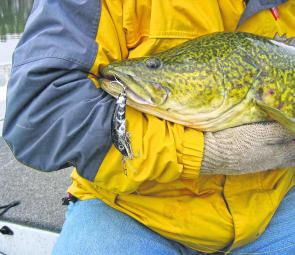
Just under 70cm of Murray cod from 5’ of water. This is the perfect place to fish a pepe coloured No. 2 StumpJumper.
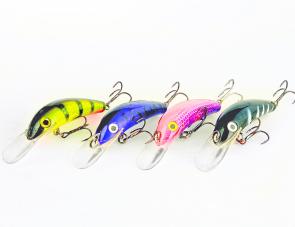
My favourite colours include (left to right) 28 green scale, 44 people eater, FWF pink and purple (not available) and the ever reliable 45 pepe. And yep I am a fan of the clear, deep diving bib.
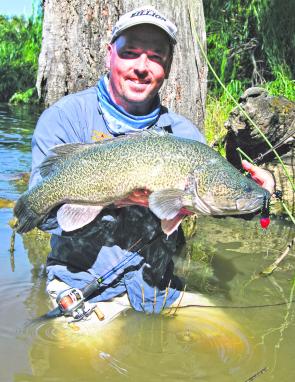
With fish like this caught on a cast and retrieved No. 2 Stumpy, why wouldn’t you want to clip one on?
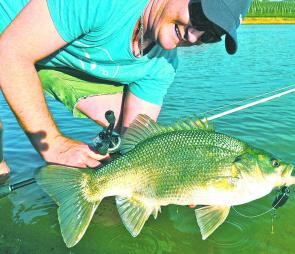
Good mate Adam Royter was searching for a golden in a lake when around 3.6kg of Aussie bass slammed his No. 2 pepe coloured StumpJumper. Awesome!

Goldens inhaling the No. 2 is nothing new. They’ve been doing it for over 20 years for us!

A recent pic with an old Stumpy colour. The Freshwater Fishing pink and purple Stumpy was once termed the illegal lure by our fishing crew because it simply caught too many! If only I could find a hidden stash of these somewhere.
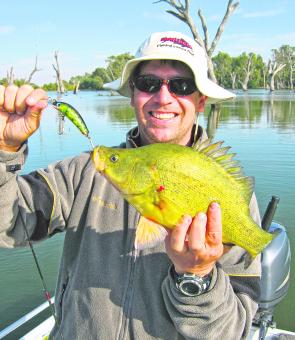
Unusual only by the fact that this golden was pinned on the rear hooks of this green scale Stumpy. Usually they will take the lure belly first and get tangled up on the middle treble.
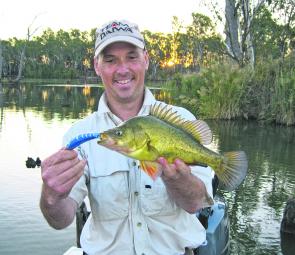
Even Fisheries Victoria had some custom painted Stumpies made in their corporate colours. And guess what? They worked just fine as Marc Ainsworth found out ‘field testing’ the colour.
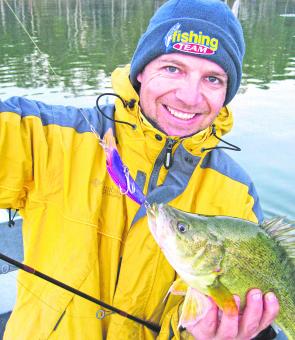
Cold late autumn and early winter days are perfect for slow rolling Stumpies around the sangs. The Freshwater Fishing colour strikes again!
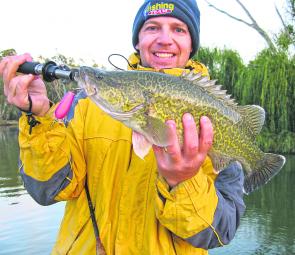
Even small cod bring a smile to my dial, especially when they come on cast lures fished in shallow water.




